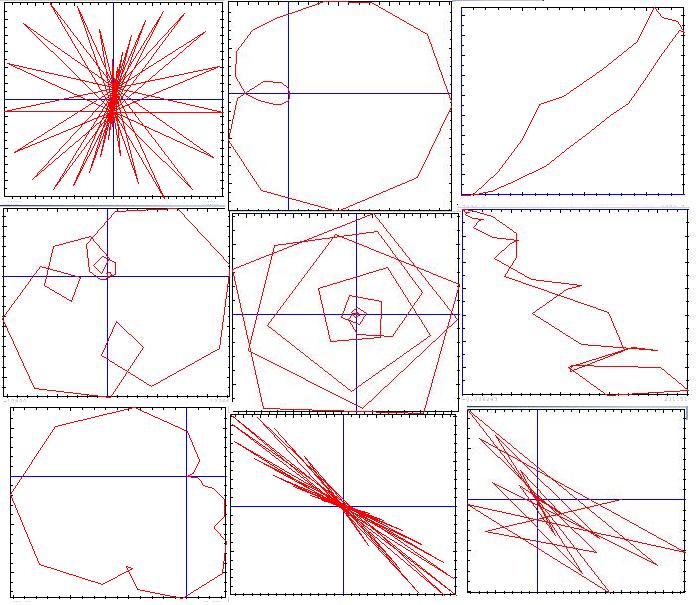This is based on მამუკა ჯიბლაძე's (not-)answer here. I guess it is better to make up a new thread for it.
Let me repeat the setup here: We consider polynomials whose complex roots are randomly distributed in various senses (say, uniformly in a square around zero). Can something be said about the distribution of the coefficients?
I have taken 500 random complex numbers chosen uniformly in a unit square around O, i.e. $[-\frac12,\frac12 ]\times [-\frac12,\frac12]$, and have PARI display the coefficients of the polynomial with those 500 roots. Consecutive ones are joint, and the precision \p1000 I chose should yield accurate graphics.
Doing this for several dozens of polynomials, here are some kinds of patterns that arise repeatedly. Most of them are different from those displayed by მამუკა ჯიბლაძე, though I did get cycloid-like shapes (but less "smooth") from time to time. The three rightmost ones are more irregular, which seems to occur less frequently.

What they mostly seem to have in common is the fact that the arguments of consecutive coefficients tend to be quite equally spaced, which is why linking them yields spirals (like #2 and #5) or star-like constellations (like #1 and #8). So I have displayed the arguments of the coefficients in order. (The argument is only defined modulo $\pi$, so if the difference of two consecutive ones is $>\dfrac\pi2$ in absolute, I have corrected it by $\pm\pi$ to get rid of unnatural jumps in the display. Some of the "folds" (or "reflections") are probably still due to that, e.g. in #4 and #8 below, at places where the slope is close to $\pm\frac\pi2$.) Note that the following graphs don't correspond to the same polynomials as above, but are again chosen to give a quite representative idea of what can happen. I have included here the y-axis graduation for convenience.

It turns out that more often than not, the curve of arguments is approximatively "piecewise linear". Can this statistically be explained?
Note that much can be explained in a similar way as David Speyer's answer to an earlier question, but for the angles (arguments) it seems less obvious to me.
It is a good idea to divide all zeros of this "raw polynomial" $\sum c_kx^k$ by $\sqrt[n]{|c_0|}$. This planar scaling doesn't change the above angles (arguments) and makes the polynomial more "symmetric". BTW, as for the (decimal logarithms of) absolute values of the coefficients, all curves, once scaled, are close to the parabola-like one given by მამუკა ჯიბლაძე.

